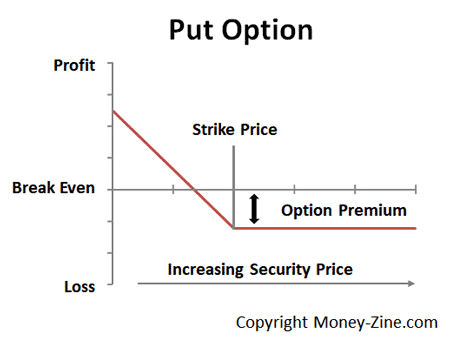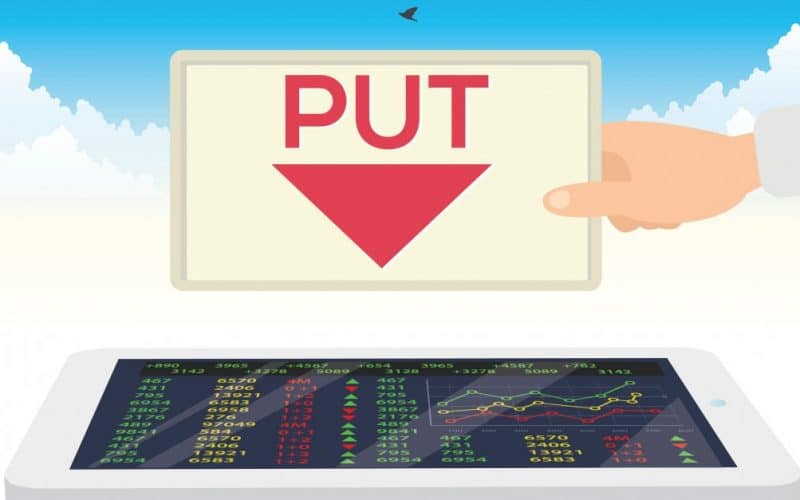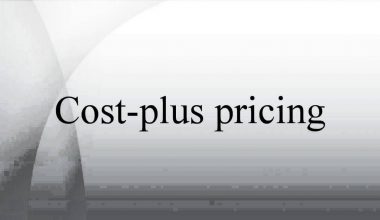Oftentimes, trading stock options can be complex, sometimes even more than stock trading itself. So, buying and selling put options requires an understanding of advanced strategies and the processes of how to trade. Moreso, a put options trading account includes a few more steps than opening a typical investment account. We see the simple steps on how to trade a put option with some examples.
What is a Put Option?
A put or put option is a financial market derivative instrument that gives the holder, the right to sell an asset, at a particular price, by (or at) a particular date to the writer (i.e. seller) of the put. The holder here means the person buying the option, while the particular price is known as the strike. Buying a put option is seen as a negative sentiment about the future value of the underlying stock. The term “put” comes from the fact that the owner has the right to “put up for sale” the stock.
Put options are most commonly used in the stock market to protect against a fall in the price of a stock below the strike.
Buying a Put Option

Similar to call options, one can buy put options through brokerages like Fidelity or TD Ameritrade (AMTD). These are financial instruments similar to stocks or bonds, hence they are tradable in a similar fashion. However, the process of buying put options is somewhat different as they are essentially a contract on underlying securities.
So to trade options in general, you will need approval by a brokerage for a certain level of options trading. This is according to a form and variety of criteria that typically classifies the investor. The investor can be put into one of four or five levels. Also, trade options can be traded over-the-counter (OTC). This eliminates brokerages and it is party-to-party.
Options contracts are typically comprised of 100 shares and can be set with a weekly, monthly, or quarterly expiration date (although the time frame can vary). In buying an option, the two main prices the investor considers are the strike price and the premium. For example, you could buy a put option for Facebook (FB) at an $8 premium with a strike price of $142. This means you are agreeing to sell the shares at $142 once the contract expires if you choose to.
However, time value, volatility is the elements that determine both strike and the premium prices
Time Value, Volatility and “In the Money”
So apart from the market price of the underlying security, other factors affect the total capital investment. This includes time value, volatility, and whether or not the contract is “in the money.”
The time value of a put option is the probability of the underlying security’s price going below the strike price before the expiration date of the contract. As a result, all put options are experiencing time decay. This implies that the value of the contract decreases as it nears the expiration date. Consequently, they are less valuable as they get closer to the expiration date.
Factors Influencing the Price of a Put
Because of the influence of time decay, the value of a put option drops as its expiration date approaches. Time decay accelerates as an option’s expiration date approaches because there is less time to profit from the trade. When an option loses its temporal value, just the intrinsic value remains. The intrinsic value of an option is equal to the difference between the strike price and the underlying stock price. When an option has inherent value, it is said to be in the money (ITM).
Option Intrinsic Value = Difference between Underlying Security Market Price and Option Strike Price (For Put Option, IV = Strike Price minus Market Price of Underlying Security; for Call Option, IV = Market Price of Underlying Security minus Strike Price).
Put options that are out of the money (OTM) or at the money (ATM) have no intrinsic value because there is no profit to exercise the option. Investors can sell the stock short at the current higher market price rather than exercising an out-of-the-money put option at an unfavorable strike price. Outside of a bear market, however, short selling is usually riskier than buying put options.
The premium of the option reflects time value or extrinsic value. If a put option has a strike price of $20 and the underlying stock is now trading at $19, the option has $1 of intrinsic value. However, the put option may be worth $1.35. Because the underlying stock price may fluctuate before the option expires, the extra $0.35 represents the time value. Put spreads are formed by combining different put options on the same underlying asset.
When it comes to selling put options, there are various aspects to consider. When considering a transaction, it’s critical to grasp the value and profitability of an option contract, or else you risk the stock falling below the point of profitability.
Buying a Put Option Example
So, buying a put option means you are “putting” the obligation to buy the shares of security you’re selling with your put on the other party at the strike price. The strike price is not the market price of the security. So, the investor is essentially betting that, at the time of the expiration of their contract, the price of the underlying asset (be it a stock, commodity, or even ETF) will go down. This now gives the investor the opportunity to sell shares of that security at a higher price than the market value. Thus, he earns a profit.
For example, You wanted to buy a put option on Intel (INTC) stock at a strike price of $50 per share. You are expecting the stock to go down in price in six months to sit at around $42 or $45, you could make a decent profit by exercising your put and selling those shares at a higher price if the market price of the stock goes down like you thought it would.
Example 2.
Another example is thinking of a put option as an insurance policy. If you own your home, you’ll be conversant with purchasing homeowner’s insurance. As a homeowner, you buy a homeowner’s policy to protect your home from damage. They pay an amount called the premium, maybe for a year. The policy has a face value and gives the insurance holder protection if the home gets damaged.
What if, instead of a home, your asset was a stock or index? So likewise, if an investor wants insurance on their S&P 500 index portfolio, they purchase put options. An investor may fear that a bear market is near and may be unwilling to lose more than 10% of their long position in the S&P 500 index. If the S&P 500 is trading at $2500, they can purchase a put option giving the right to sell the index at $2250, for example, at any point in the next two years.
So if in six months the market crashes by 20% (500 points on the index), they have made 250 points by being able to sell the index at $2250 when it is trading at $2000. This is a combined loss of just 10%. So, even if the market drops to zero, the loss would only be 10% if this is held. Also, purchasing will carry a cost (the premium), and if the market doesn’t drop during that period, the maximum loss on the option is just the premium spent.
Read Also: Sell Put Options Overview with Options Trading Examples
How to Trade Options
There are some things that you need to have into consideration when you want to go into options trading. You know the risks involved and also know to manage them before starting the opening of the account.
#1. Open an Options Trading Account
So before you start trading options, you’ll have to prove you know what you’re doing. (Need to brush up on other options trading terms? See our post on options trading). In contrast with opening a brokerage account for stock trading, opening an options trading account requires larger capital. As a result of the complexity of predicting multiple moving parts, brokers need to know more about potential investors before awarding them a permission slip to start trading.
Brokerage firms examine potential traders to assess their trading experience and their financial preparedness. You keep these details in the trading agreement. You can use it to request approval from your prospective broker.
The required details include:
- Investment objectives: This includes income, growth, capital preservation, or what the investor expects.
- Trading experience: The broker will require your knowledge of investing and how long you’ve been trading. The broker will also need to know how many trades you make yearly and the size of your trades.
- Personal financial information. You should have in hand your liquid net worth, annual income, total net worth, and employment information.
- The types you want to trade. It can be calls, puts, or spreads and know whether they are covered or naked.
From the analysis of your information, the broker typically assigns you an initial trading level based on the level of risk. It is typically 1 to 5, with 1 being the lowest risk and 5 being the highest. This will be your guide in placing the trades.
Screening should go either way. You should find a broker that offers the tools, research, guidance, and support you need. This is especially important for investors who are new to trading.
#2. Pick which Options to Buy or Sell
A call option is a contract that gives you the right, but not the obligation, to buy a stock at a predetermined price within a certain time period. A put option gives you the right, but not the obligation, to sell shares at a stated price before it expires.
So, depending on which direction you expect the underlying stock to move determines what type of options the contract is to take on.
- So if you think the stock price will move up: buy a call, sell a put.
- If you think the stock price will stay stable: you sell a call or sell a put.
- If you think the stock price will go down: you buy a put, sell a call.
#3. Predict the Option Strike Price
In buying an option, it remains valuable only if the stock price closes the option’s expiration period “in the money.” This implies it’s either above or below the strike price. (For call, it’s above the strike and for put, it’s below the strike.) You’ll want to buy an option with a strike price that reflects where you predict the stock will be during the option’s lifetime.
For example, if you believe the share price of a company currently trading for $120 is going to rise to $150 at a future date, you’d buy a call option with a strike price less than $150. If the stock eventually rises above the strike price, your option is in the money.
Likewise, if you believe the company’s share price is going to dip to $100, you’d buy a put option with a strike price above $100. So when the stock drops below the strike price, your option is in the money.
The price you pay for an option, called the premium, has two components: intrinsic value and time value. Intrinsic value is the difference between the strike price and the share price if the stock price is above the strike. Time value is whatever is left, and factors in how volatile the stock is, the time to expiration, and interest rates, among other elements.
This leads us to the final choice you need to make before buying an options contract.
#4. Determine the Option Time Frame
All options contract has an expiration period that shows the last day you can exercise it. You cannot choose any date you like. You can only make your choices from the options they offer
We have two styles of options, American and European. They differ depending on when you can exercise the options contract. Holders of an American option can exercise at any point up to the expiry date. However, holders of European options can only exercise on the day of expiry. Consequently, as American options offer more flexibility for the option buyer, they usually cost more than their European counterparts.
The expiration dates can range from days to months and even years. Daily and weekly ones are the riskiest. They are reserved for seasoned traders. But for long-term investors, monthly and yearly expiration dates are preferable. Longer expirations give the stock more time to move and time for your investment set-up to play out. So, the longer the expiration period, the more expensive the option.
Alternatives to Exercising a Put Option
The buyer of a put option is not required to hold the option until it expires. As the underlying stock price changes, the premium of the option changes to reflect the most recent underlying price movements. The option buyer can sell their option and either minimize their loss or achieve a profit, depending on how the price of the option has changed since they purchased it.
Similarly, the option writer can do the same thing. If the underlying price is higher than the strike price, they may do nothing. This is due to the possibility that the option would expire with no value, allowing them to keep the entire premium. However, if the underlying price approaches or falls below the strike price, the option writer may simply buy the option back to avoid a large loss (which gets them out of the position). The profit or loss is the difference between the premium earned and the premium paid to exit the trade.
How does one hedge with put options?
Hedging with put options involves buying a put option to protect against a potential decline in the value of an underlying asset. By buying a put option, the holder has the right to sell the underlying asset at the strike price if its value decreases. This allows the holder to limit their potential losses in the event of a decline in the value of the underlying asset.
What is a covered put option?
A covered put option is a strategy in which a trader holds both a short position in a stock and a put option on that stock. The trader sells the put option to generate additional income, with the expectation that the stock will remain flat or increase in value. If the stock price decreases, the trader must purchase the stock to sell it at the higher strike price specified in the put option, hence the term “covered”.
What is a naked put option?
A naked put option is a strategy in which a trader sells a put option without owning the underlying asset. This strategy involves a higher level of risk as the trader is exposed to unlimited losses if the price of the underlying asset decreases significantly. The trader must purchase the underlying asset at the strike price if the option is exercised, which can result in significant losses if the price has decreased.
What is a cash-secured put option?
A cash-secured put option is a strategy in which a trader sells a put option and holds an equivalent amount of cash in their account to cover the potential cost of buying the underlying asset if the option is exercised. This strategy allows the trader to generate income while limiting their potential losses.
How does a put option benefit the buyer?
A put option benefits the buyer by giving them the right to sell an underlying asset at a specified price (strike price) before the option’s expiration date. This allows the buyer to protect against a potential decline in the value of the underlying asset, or to lock in a profit if the asset has already increased in value.
How does a put option benefit the seller?
A put option benefits the seller by generating income in the form of the premium received for selling the option. The seller collects the premium whether or not the option is exercised, as long as they remain committed to the option until its expiration date. The seller is obligated to purchase the underlying asset at the specified price if the option is exercised, which can result in losses if the price of the asset has increased.
What is the potential profit or loss for a put option buyer or seller?
The potential profit for a put option buyer is limited to the premium received for the option, while the potential loss is unlimited if the price of the underlying asset increases. The potential profit for a put option seller is limited to the premium received, while the potential loss is unlimited if the price of the underlying asset decreases significantly.
Put Options FAQs
Why would you buy a put option?
Traders purchase put options to increase their profit from a stock’s drop. For a nominal upfront fee, a trader can profit from stock prices below the strike price until the option expires. When you buy a put option, you normally expect the stock price to fall before the option expires.
How do puts and options work?
As the price of the underlying stock falls, the value of a put option grows, implying that the premium rises. When the stock price rises, the premium on a put option falls or loses value. When put options are exercised, they provide investors a sell position in the stock.
How do puts make money?
Puts profit when the option’s price rises, or when you exercise the option to buy the stock at a price lower than the strike price and subsequently sell the stock in the open market, pocketing the difference. By purchasing a put option, you restrict your risk of loss to the premium you paid for the put option.
When should you sell a put?
Because you are incurring an obligation to buy if the counterparty chooses to execute the option, investors should only sell put options if they are comfortable owning the underlying securities at the predetermined price.
- SHORT CALL: Best easy guide to master short call strategy
- Trading Deep in the Money Options – Risks to consider
- SELL TO OPEN: Overview with options trading examples
- How to Spot High Yield Investments (Easy Guide)
- OPTIONS TRADER: Definition, Salary & How To Become A Trader Guide
- Long Put: The Complete Beginners’ Guide (+Quick Tools)






